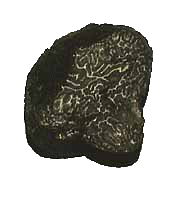

OK, I confess I have never found a truffle in the wild. This was a gift from my mycophile friend Clay Singer, and I felt compelled to add it to the photo galley simply to pay it the respect it is due. The black truffle grows wild in Perigord, France, at the roots of oak trees. As it grows a few inches under the ground, truffle collectors use trained dogs (or pigs in the old days) to sniff them out. They have discovered how to inoculate the tree roots with spores to guarantee crops in the years to come.
Nothing smells even remotely like a fresh truffle. It posseses one of the most complex fragrances I have ever experienced. Imagine a mixture of raspberries, musk, walnuts, leaf litter, persperation and aged port wine...only, well... deeper. An erotic fragrance, sensual, mysterious and evasive.
Personally, I find that the smell of the truffle comes before its flavor, and you must be careful not to overpower either the smell or the taste when cooking with it. Simplicity rules. Eggs carry the fragrance very well, as does rice, cream sauce and other bland carriers. You might make a simple omelette, or a quiche, then shave some paper thin slices of truffle on top.
To keep a truffle from spoiling, store it in a small, tightly sealed jar, filled with rice. The rice will keep the truffle dry, and will also absorb some of its fragrance. Once you have used the truffle, you can still use the rice to make a subtle and exquisite reminder of past extravagance.